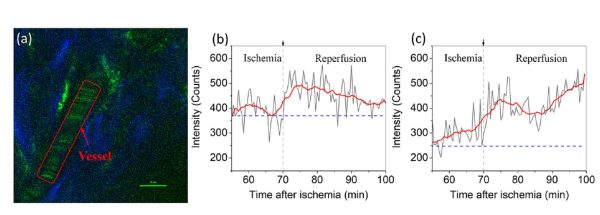News Express: UM’s research in acute mesenteric ischemia helps reduces mortality of patients
新聞快訊:澳大急性腸缺血研究助降低死亡率

活體核黃素螢光影像(a)顯示腸缺血(ischemia)70分鐘後,再灌流(reperfusion)傷害導致血管(vessel)內螢光逐漸上升(b, c)。
The image of flavin fluorescence in vivo (a) shows a gradual increase of flurorescence in the vessel (b, c) due to reperfusion injury after 70 minutes of ischemia
澳大急性腸缺血研究助降低死亡率
澳門大學健康科學學院副教授劉子銘研究團隊在急性腸缺血研究上取得了重大進展。該研究發現血中核黃素(維生素B2)的濃度與腸缺血時長和小腸損傷程度相關,可以發展成為新型診斷標誌物,極大縮短檢測時間,從而降低死亡率。相關研究已在國際期刊《血栓研究》(Thrombosis Research)上刊登。
急性腸缺血的臨床症狀易與其他腸道炎症性疾病混淆,臨床資料顯示,未能準確地在發病前預測到急性腸缺血而延誤診治,會引發全身性反應綜合症以及多器官功能衰竭,導致致死率高達60-80%。因此,針對急性腹痛患者,如何準確診斷急性腸缺血,避免延誤診治,仍是重症醫學需面對的問題。
目前對急性腸缺血的臨床診斷方法主要是基於一些生物標誌物的檢測以及CT影像診斷。然而,這些生物標誌物的測定不僅耗時、可靠度較低,且個體差異大,CT影像則只有在疾病晚期才能確診。因此,研究團隊為了縮短早期的診斷時間,提出運用一種無需試劑的螢光診斷方法。
該方法利用不同波長激發血液螢光,透過不同螢光分子的訊號強度,對急性腸缺血進行病理判斷。實驗數據顯示,在大鼠遭受急性腸缺血後,腸道會向血液釋放大量核黃素,通過監測血漿中核黃素的螢光強度,可以得知疾病發展狀態。核黃素螢光強度不僅與缺血時間成正比,兩個不同螢光分子的螢光強度比(flavin/NADH)還可以反映休克的發生。另外,血漿螢光檢測可以在2分鐘內完成,相比傳統的生物標誌物檢測(2~4小時),不僅無需額外的試劑成本,還有顯著的時間優勢。
該研究的通訊作者為劉子銘,其博士生吳雪琴為第一作者,台灣大學博士生郭倫彰和劉奕宏為共同第一作者。澳大健康科學學院前研究助理劉又誠,廈門大學教授戴桓青,台灣大學教授王宗道、周必泰、賴逸儒及醫師賴超倫和莊岳勳也對研究作出了重要貢獻。該項目由澳門特別行政區科學技術發展基金(檔案編號:122/2016/A3,018/2017/A1,0011/2019/AKP,0120/2020/A3,0026/2021/A),澳門大學(檔案編號:MYRG2018-00070-FHS)資助。全文可瀏覽https://www.sciencedirect.com/science/article/pii/S0049384823000397?via%3Dihub。
欲瀏覽官網版可登入以下連結:
https://www.um.edu.mo/zh-hant/news-and-press-releases/campus-news/detail/55427/
UM’s research in acute mesenteric ischemia helps reduces mortality of patients
A research team led by Liu Tzu-Ming, associate professor in the Faculty of Health Sciences (FHS) at the University of Macau (UM), has made a breakthrough in the diagnosis of acute mesenteric ischemia (AMI). The study found that the level of riboflavin (vitamin B2) in the blood correlates with the duration of intestinal ischemia and the degree of damage to the small intestine, making it a new diagnostic biomarker that can contribute to efficient early screening and reduce the mortality of patients. The research results have been published in the international journal Thrombosis Research.
The clinical symptoms of AMI are easily confused with those of other intestinal inflammatory diseases. Clinical data shows that failure to accurately predict the onset of AMI early and delayed diagnosis and treatment can lead to systemic response syndrome and multi-organ failure, resulting in a high mortality rate of 60 to 80 per cent. Therefore, accurate diagnosis of AMI remains a critical scientific problem in critical care medicine for patients with acute abdominal pain, as it can help avoid delayed diagnosis and treatment.
Currently, the clinical diagnosis of AMI relies on biomarker assays and CT imaging. However, biomarker assays are not only time-consuming but also unreliable due to significant individual variations in baseline levels, while CT imaging can only confirm the diagnosis of AMI at advanced stages of the disease. In view of this, the research team proposed a reagent-free fluorescence diagnosis method to reduce the time needed for early diagnosis.
The research team excited blood fluorescence at different wavelengths and used the fluorescent intensity to determine the pathology of AMI. The data showed that the intestine of AMI rats released a significant amount of riboflavin into the bloodstream, and the disease development can then be assessed by monitoring the fluorescence intensity of riboflavin in plasma. The intensity of riboflavin fluorescence is proportional to the duration of ischemia, and the ratio of fluorescence intensity of two different fluorescent molecules (flavin/NADH) can reflect the onset of shock. Furthermore, the plasma fluorescence assay takes less than two minutes to perform and does not need any additional reagents, providing a significant time advantage over traditional biomarker assays, which can take two to four hours.
Prof Liu is the corresponding author of the paper, his PhD student Wu Xueqin from UM is the first author, and PhD students Guo Lun-Zhang and Liu Yi-Hung from Taiwan University are the co-first authors. In addition, former research assistant Liu Yu-Cheng of UM FHS, Prof Tai Hwan-Ching from Xiamen University, professors Wang Tzung-Dau, Chou Pi-Tai and Lai I-Rue, and doctors Lai Chao-Lun and Chuang Yueh-Hsun from Taiwan University also made significant contributions to the study. The project was funded by the Science and Technology Development Fund of Macao SAR (File no: 122/2016/A3, 018/2017/A1, 0011/2019/AKP, 0120/2020/A3, 0026/2021/A), UM (File no: MYRG2018-00070-FHS). To view the full version of the paper, please visit: https://www.sciencedirect.com/science/article/pii/S0049384823000397?via%3Dihub.
To read the news on UM’s official website, please visit the following link:
https://www.um.edu.mo/news-and-press-releases/campus-news/detail/55427/